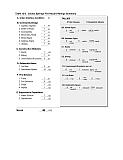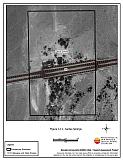12.0 Cactus Springs
12.1 Risk and Hazard Assessment
Cactus Springs is 48 miles northwest of Las Vegas on US Highway 95, adjacent to a military installation. The area on the east side of the highway was previously commercial but the businesses are now abandoned. Five residences were observed in Cactus Springs. The community was placed in the Moderate Hazard category (46 points). The moderate rating is primarily attributed to the lack of local fire suppression personnel, local water sources, and defensible space. Table 12-3 at the end of this section presents a summary of the community hazard rating values for Cactus Springs.
12.1.1 Community Design
Cactus Springs demonstrates a classic wildland-urban interface condition, with a clear line of demarcation between building structures and wildland fuels. Residential structures are located mainly along the highway. Parcels are less than one acre in size. The community boundary is shown in Figure 12-1.
- Access: Cactus Springs lies along US Highway 95, a paved four-lane road. All secondary roads are unpaved. There is adequate room for fire suppression equipment to maneuver.
- Signage: Clear and visible street signs and residential addresses are always important in locating homes, especially for rescue personnel unfamiliar with an area and the low visibility conditions that may occur during a wildfire. Due to the very limited number of residences in Cactus Springs, there is little chance that fire suppression personnel would be unable to locate a particular structure in need of protection.
- Utilities: Utilities are both above and below ground. Utility corridors are well maintained and pose a low ignition risk.
12.1.2 Construction Materials
All of the homes in the interface are built with non-combustible roofing and siding materials. Four of the five homes in the community have unenclosed balconies, decks, porches, eaves, or attic vents that can create drafty areas where sparks and embers can be trapped, smolder, ignite, and rapidly spread fire to the house.
12.1.3 Defensible Space
Four of the five homes do not meet the defensible space landscaping requirement to minimize the risk of property damage or loss of a home during a wildfire. Accumulations of weeds and debris along fences and near residential structures are common.
12.1.4 Suppression Capabilities
Wildfire Protection Resources
The nearest fire protection resources for Cactus Springs are located at Indian Springs, three miles to the east. These resources include a 36-member volunteer fire department and fire suppression resources attached to the US Air Force installation at Indian Springs. The Nevada Division of Forestry also administers a conservation work camp at Indian Springs with the capacity to house a fire crew of a dozen. Additional County resources would be dispatched through the Clark County Fire Alarm office. Table 12-1 lists the resources most likely be the first to respond to a reported wildland fire. This information is based on data available at the time of interviews with local and regional fire authorities and are subject to change.
| Type of Resource | Amount of Equipment | Cooperating Partner (Resource Location) |
|---|---|---|
| Type 1 Structure Engine Type 6 Quick Attack Engine Basic Life Support (BLS) Rescue |
1 1 1 |
Clark County Fire Department (Indian Springs Station 83) |
| Type 4 Brush Engine Type 6 Brush Patrol Engine |
1 1 |
US Forest Service (Indian Springs Station 83) |
| Type 1 Structure Engine Type 6 Quick Attack Engine Basic Life Support (BLS) Rescue |
1 1 1 |
Clark County Fire Department (Cold Creek Station 82) |
| Source: Steve McClintock, Kurt Leavitt, Mark Blankensop, pers. comm. March 2004. | ||
Federal resources called to respond to a fire in Cactus Springs would be dispatched through the Las Vegas Interagency Communications Center. The Nevada Division of Forestry conservation crew stationed in Cactus Springs is dispatched through the Sierra Front Interagency Dispatch Center in Minden, Nevada. These systems locate the nearest available fire suppression resource according to incident command and computer aided dispatch protocols. It is important to note that Federal resources are commonly reassigned to areas of higher severity during the fire season.
Water Sources and Infrastructure
Water availability for fire suppression in Cactus Springs includes wells and a 40,000-gallon storage tanks at Indian Springs.
Fire Protection Personnel Qualifications
Volunteer and career firefighters who would respond to a wildfire near Cactus Springs have a minimum of NFPA firefighter I and II training and a limited number have had some wildland firefighting training (National Wildfire Coordinating Group 310-1). The Nevada Division of Forestry and US Forest Service personnel meet minimum requirements per National Wildfire Coordinating Group 310-1.
Work Load
In 2003 the Indian Springs Fire Department responded to 42 emergency medical calls and thirteen wildland brush fire calls.
Financial Support
Financial support for the Clark County Fire Department in Indian Springs comes from the County General Fund, which is generated primarily through property taxes.
Community Preparedness
Cactus Springs is covered under the Clark County All-Risk Emergency Plan. The Clark County Fire Department reviews development plans for the entire County to ensure compliance with the 1997 (with amendments) Uniform Fire Code standards. There are no brush clearance programs in Cactus Springs.
12.1.5 Factors Affecting Fire Behavior
The dominant vegetation in the Cactus Springs area is Mojave Desert shrub consisting of creosote bush with an understory of annual grasses. There are scattered mesquite and poplar trees. The fuel density is light, estimated at less than one ton per acre, which was considered a low fuel hazard.
12.1.6 Fire Behavior Worst-Case Scenario
Winds from the south/southwest would drive a fire through the community. Weed accumulations along fences and surrounding homes would fuel a fire, and the lack of defensible space would allow the fire to spread from these fuels directly to homes. The lack of fire protection and water sources increases the risk of property loss from a fire.
12.1.7 Ignition Risk Assessment
Cactus Springs has a low ignition risk rating. There is no recorded wildfire history in the areas surrounding the community, and database records show the nearest ignitions to have occurred more than 25 miles away.
12.2 Risk and Hazard Reduction Recommendations
The Cactus Springs Risk Reduction Recommendations focus on defensible space. Specific recommendations are detailed below.
12.2.1 Defensible Space
Vegetation density, type of fuel, and slope gradient around a home affect the potential fire exposure levels to the home. These conditions define the defensible space area required for individual homes. The goals of defensible space are to reduce the risk of property loss from wildfire by eliminating flammable vegetation near the home. In turn, this lowers the chances of a wildfire spreading onto adjacent properties and it aids firefighters in their efforts to protect property against an approaching wildfire. Guidelines for establishing and improving defensible space around residences and structures in the community are given below and described in greater detail in Appendix E.
The lack of fire suppression resources increases the risk of damage and property loss due to a fire before fire protection resources could arrive from Indian Springs. It is important for the residents of Cactus Springs to take precautions to reduce fire hazards in their community.
Property Owners
- Remove, reduce, and replace vegetation around homes. Keep this area:
- Lean: There are only small amounts of flammable vegetation.
- Clean: There is no accumulation of dead vegetation or other flammable debris.
- Green: Existing plants are healthy and green during the fire season.
- Thin shrubs and other brush to a distance equal to twice their height (crown to crown).
- Remove shrubs and annual vegetation from vacant lots in the community.
- Mow and remove annual grasses from along fences and from areas surrounding homes and other structures.
- Enclose wood decks and porches. If this is not possible, keep the area beneath wood decks and porches free of weeds and other flammable debris. Where possible, install screens around unenclosed overhangs.
- Immediately remove all cleared vegetation to an approved disposal site. This material dries quickly and poses a fire risk if left on site.
- Maintain defensible space annually.
12.2.2 Fuel Reduction Treatments
Recommendations provided below focus on the reduction of fuels along roadways in key locations around the Cactus Springs community. If properly maintained, a roadside fuelbreak can eliminate the continuity of fuels in the tree, shrub, and ground layers. As a result, the heat intensity and rate of spread of an oncoming wildfire can be reduced considerably, offering conditions where a fire can be more safely and effectively managed on the ground.
Nevada Department of Transportation
- Reduce or remove red brome and other annuals along US Highway 95 and local roadways by mowing or applying pre-emergent herbicide prior to seed maturity. Treatments may need to be repeated in successive years. Reseed with fire resistant species such as recommended in Appendix E if necessary to control invasion of noxious weeds.
12.2.3 Public Education
- Distribute copies of the publication “Living with Fire.”This publication is available free of charge from the University of Nevada Cooperative Extension.
12.3 Summary of Recommendations
| Involved Party | Recommended Treatment | Recommendation Description |
|---|---|---|
| Property Owners | Defensible Space | Remove, reduce, and replace vegetation around homes according to the guidelines in Appendix E. Maintain defensible space as needed to keep the space lean, clean, and green. |
| Public Education | Request copies of the publication “Living with Fire” from the University of Nevada Cooperative Extension. | |
| Nevada Department of Transportation | Fuels Reduction | Remove flammable annual grasses from roadsides and reseed with fire resistant species. |
Table 12-3. Cactus Springs Fire Hazard Ratings Summary |
 |
Figure 12-1 Cactus Springs |
 |
